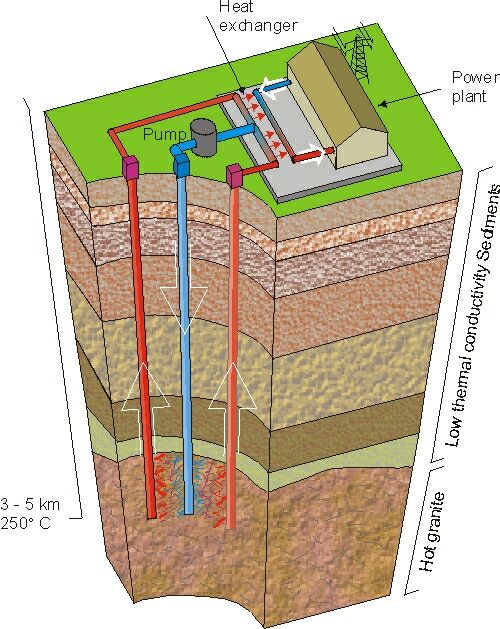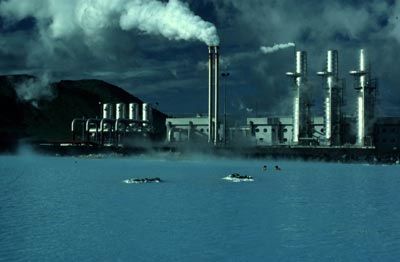 The
diagram on the left gives an indication of how geothermal hot dry
rock energy is produced.
The
diagram on the left gives an indication of how geothermal hot dry
rock energy is produced.
Geothermal Energy
Geothermal energy, as its name suggests, is energy harnessed from the earth’s underground heat. Because the earth eventually replaces the heat, geothermal energy has been classified by organizations such as the International Energy Agency and the Australian Greenhouse Office as a renewable source of energy. During operation, geothermal power plants do not emit carbon dioxide and therefore is considered ‘green’ energy.
There are two forms of geothermal energy; geothermal aquifer and geothermal hot dry rock.
Geothermal Aquifer
Geothermal Aquifers exploit heat from the earth’s crust through naturally occurring ground waters in deep porous rocks. The exploitation of these aquifers as a source of energy requires a production borehole to extract the water and usually an injection hole to dispose of the cooled water.
Geothermal Hot Dry Rock
 The
diagram on the left gives an indication of how geothermal hot dry
rock energy is produced.
The
diagram on the left gives an indication of how geothermal hot dry
rock energy is produced.
Water is injected into a borehole and circulated through a "heat exchanger" of hot cracked rock several kilometres below the surface. The water is heated through contact with the rock and is then returned to the surface through another borehole where it is used to generate electricity.
The water is then re-injected into the first borehole to be reheated and used again.
B1b2_e1
Installation
Power Stations: According to a conservative estimate by the Centre for International Economics, Australia has enough geothermal energy to meet our total electricity consumption for 450 years. Geodynamic, an Australian geothermal company, assisted by $11.8 million in federal grants, said it would produce one megawatt of electricity for about $45 an hour - compared with coal power (which is heavily subsidised) of about $35. The greatest cost of geothermal energy is the initial building, as to drill one commercial borehole can cost up to $10 million.
Domestic Systems: Popular in New Zealand, a geothermal heating system is estimated at A$12,000. The system is expected to work for at least 50 years with annual maintenance costs of less than $300. Based on average household energy costs, this still maintains a net saving of 3.3%.
The diagrams below illustrate such a domestic geothermal heating and cooling systems, using the constant ground temperature for both heating and cooling.
The largest geothermal power plant complex is located in Geysers in northern California, USA. It's total output of 850MW equates to one million barrels of oil each year. http://www.thegga.org
Iceland relies heavily on geothermal energy with 87% of the country’s electricity originating from geothermal sources.

People swimming in front of a geothermal power plant in Iceland.
Geothermal is a reliable and cost effective base load energy and in Australia it can supply as much or more energy than nuclear, it can do so sooner, safer and without leaving a poisenous legacy to thousands of future generations.
B1b2_e1